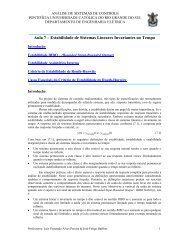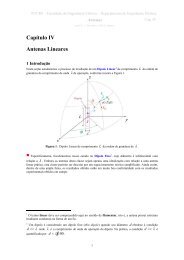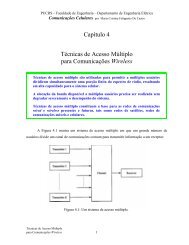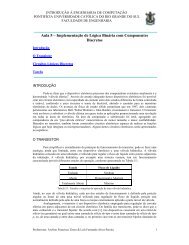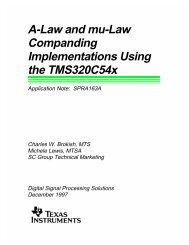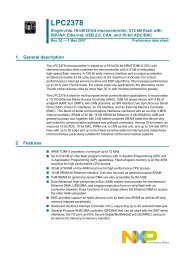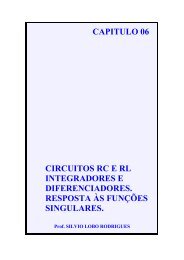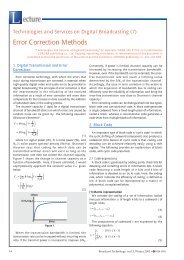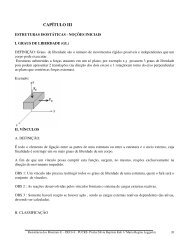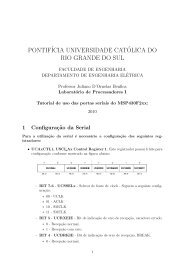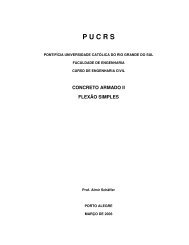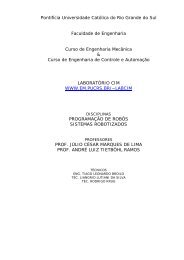Create successful ePaper yourself
Turn your PDF publications into a flip-book with our unique Google optimized e-Paper software.
APPLICATION INFORMATION (cont.)<br />
The average input current at minimum line and maximum<br />
load will be<br />
IIN = IOUT<br />
η<br />
in this case<br />
IIN = 500mA<br />
0.5<br />
• VOUT′<br />
VIN<br />
2V<br />
• = 20mA<br />
100V<br />
Knowing that input current is drawn from the line only<br />
during TON, calculate the peak current in L1 to be<br />
IL1(pk) = 2 • IIN •<br />
in this case<br />
TON + TOFF<br />
TON<br />
1.25μs + 8.75μs<br />
IL1(pk) = 2 • 20mA •<br />
1.25μs<br />
Now calculate the value for L1<br />
L1 = VIN • TON<br />
IL1(pk)<br />
in this case<br />
= 320mA<br />
L1 = 100V • 1.25μs<br />
= 390μH<br />
320mA<br />
The output voltage of the first flyback stage is<br />
VC1 = VIN • TON<br />
TOFF<br />
in this case<br />
VC1 = 100V • 1.25μs<br />
= 14.3V<br />
8.75μs<br />
Knowing that output current is provided to the load only<br />
during TOFF, calculate the peak current in L2 to be<br />
IL2(pk) = 2 • IOUT •<br />
in this case<br />
IL2(pk) = 2 • 0.5A •<br />
TON + TOFF<br />
TOFF<br />
Now calculate the value of L2<br />
L2 = VOUT′ • TOFF<br />
IL2(pk)<br />
in this case<br />
1.25μs + 8.75μs<br />
8.75μs<br />
= 1.14A<br />
L2 = 2V • 8.75μs<br />
= 15μH<br />
1.14A<br />
For all of the calculations so far only the maximum<br />
load/minimum line condition have been considered. The<br />
6<br />
entire range of operation must be considered to choose<br />
values for the rest of the components.<br />
Under all normal operating conditions the current ITON,<br />
(which is the current in RON), should be greater than<br />
2mA and less than 7.5mA. In this case set RON to give<br />
ITON = 2.8mA at low line. The voltage at TON will be<br />
about 11V so<br />
100V − 11V<br />
RON = = 33kΩ<br />
2.8mA<br />
With RON = 33k, ITON at high line will be<br />
180V − 11V<br />
ITON = = 5.1mA<br />
33k<br />
At high line, the power dissipation in RON will be<br />
P(RON) = (180V − 11V) • 5.1mA = 860mW<br />
RON will need to be at least a 1W resistor. Alternately it<br />
could be four 1/4W 8.2kΩ resistors in series.<br />
Once RON is set, CT can be chosen. The charge current<br />
for CT is nominally 15% of ITON, and the nominal oscillator<br />
amplitude is 3.4V, so<br />
CT • 3.4V<br />
TON =<br />
0.15 • ITON<br />
solving for CT<br />
TON • 0.15 • ITON<br />
CT =<br />
3.4V<br />
ITON at low line is 2.8mA, and the target TON at low line<br />
is 1.25μs, so in this case<br />
1.25μs • 0.15 • 2.8mA<br />
CT = = 150pF<br />
3.4V<br />
The final component to be chosen is ROFF, which determines<br />
the minimum value of TOFF. When the output<br />
voltage is below the regulation point, the discharge current<br />
for CT is equal to ITOFF (the current in ROFF). Under<br />
that condition<br />
CT • 3.4V<br />
TOFF =<br />
ITOFF<br />
since the voltage at the TOFF pin = 0.4V<br />
VOUT − 0.4V<br />
ITOFF =<br />
ROFF<br />
substituting and solving for ROFF<br />
ROFF =<br />
TOFF • (VOUT − 0.4V)<br />
CT • 3.4V<br />
UCC1890<br />
UCC2890<br />
UCC3890<br />
The largest discharge current, and hence the minimum<br />
off time, will occur when the output is about 10mV be-



